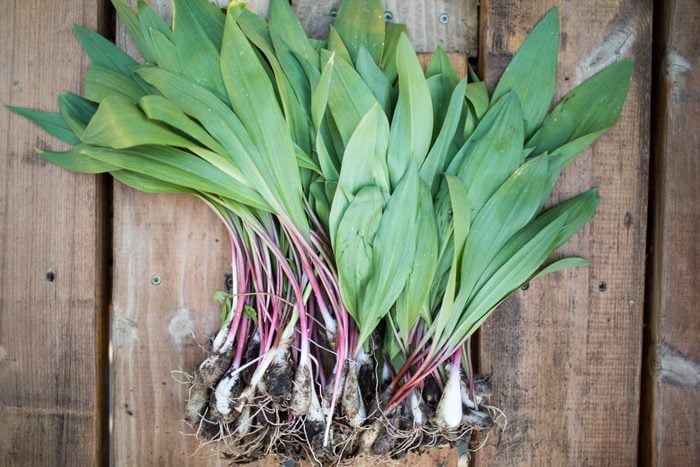What Are Ramps and How Do They Taste?
Updated: May 24, 2024

What are ramps? Well, they look like scallions but taste like garlic, and their soft leaves are as tender as spinach.
If you’re only shopping at the grocery store this spring, you’ll miss out on a handful of wild-foraged delicacies only found at the farmers market. It’s hard to know what to get most excited about: stinging nettles, fiddlehead ferns, miner’s lettuce, garlic scapes or ramps.
Whether you’ve seen them at markets before and thought what are ramps? or you’ve never heard of them until now, we’re here with a short explainer on this wild-growing allium. Keep in mind that ramp season starts in late March or early April (depending on the weather) and they’re usually gone by June, so you’ll want to jump on them when you can!
What Are Ramps?
Ramps are a member of the allium family (Allium tricoccum), just like onions and garlic. These wild-foraged onions look a lot like scallions or spring onions, but they have a dark purple stem and broader, more pillowy leaves. They’re native to the eastern half of North America and grow in the United States and Canada. They’re wildly popular in Appalachia, where they’re called “ramsons” in the local dialect. Depending on where you live, they may be referred to as wild leeks or spring onions.
What Do Ramps Taste Like?
Although ramps look like green onions, they don’t specifically taste like onions. Instead, they carry a bright, garlicky flavor profile. Think of a green onion’s flavor mixed with the pungent, spicy kick of raw garlic. That strong garlic presence makes them unique when used raw, but the strong flavor mellows out and becomes reminiscent of leeks when cooked.
Where to Buy Ramps
Ramps are almost impossible to find in grocery stores. You’re more likely to find them at a local farmers market when they’re in season. There are also several ramp festivals throughout the Appalachian region—West Virginia hosts one of the most famous ones—so you might want to plan some travel this spring if you’re a true ramp enthusiast.
Most ramps are wild-foraged and grow under hardwood trees in natural forests. That makes them more expensive than other alliums, given the high cost of labor to harvest and clean them. It is possible to grow ramps from seed, but they’re more slow-growing than other onions. A gardener with a lot of patience could probably enjoy success growing ramps in a backyard garden.
How to Store Ramps
Ramps have a very short shelf life, so you’ll want to plan to eat them within a few days of buying or foraging them. Store ramps in an airtight container or a reusable plastic bag in the crisper bin of your refrigerator for a few days. You can extend their life slightly by wrapping the roots in a damp paper towel before placing them in the bag, where they’ll last for up to four days.
Need to extend a ramp’s life longer than that? Try blanching the leaves and chopping the bulbs for the freezer. Place each component (separately) in an airtight container or a freezer bag and freeze for up to a year. Ramps are also excellent when pickled or folded into butter to make compound butter.
How to Clean Ramps
If you’ve ever worked with leeks, you know just how dirty an onion can get. Ramps are no exception, except that their layers are much smaller than leeks, making them quite a chore to clean! Remember that they’re absolutely worth it as you work on detaching clumps of dirt that cling between each onion layer.
There are several ways to wash vegetables from the farmers market, and the most typical method involves rinsing the vegetable in cold, running water. However, when it comes to ramps, we prefer to cut off the stringy bottom roots before submerging the ramps in a bowl of cold water. Swish them around to remove any dirt or sand. Then, pat them dry with a paper towel.
How to Use Ramps
The entire ramp is edible (except the tiny roots attached to the bulb), but we generally reserve the stalks and leaves for different purposes. The leaves make an excellent pesto sauce, but they can also be softened in butter or oil until they wilt and used in any recipe that calls for tender greens (like spinach). We also love fermenting the leaves alongside cabbage to make a stellar homemade sauerkraut or kimchi.
The bulbs are fantastic when grilled whole and served alongside a peppery steak or on a grilled vegetable platter. We also love tossing raw, chopped bulbs with potatoes for a bold, garlicky potato salad or mixing them with ricotta to make ravioli. There are dozens of applications for using sauteed, chopped ramps, ranging from pasta and soups and to egg dishes, tacos, pizza toppings and more.
Basically, you can substitute ramps for any recipe that calls for garlic or green onions, so have some fun with them!




















